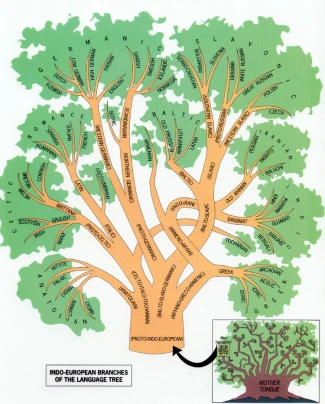To supplement last week’s discussion on language evolution, I stumbled upon an Indo-European language tree posted on Jonathan Beaton’s blog. Neither Jonathan nor I know where it was published, nor what data was used to construct the tree and its relationships. So it may not be completely accurate… but it is a nifty illustration.
Just cause I’m curious on how accurate the tree is, I’ve compared to Ethnologue’s report on Indo-European languages. The general trend on language relationships are accurate but many languages are left out.


Kambiz. Looks like it comes from a paper by Gamkrelidze and Ivanov, “The Early History of Indo-European Languages” in Scientific American of March 1990. Just found a version.
This tree looks good :-) But, of course, some people would make it different … I would place Anatolian closer to Greek, also this tree topology can not describe intermixing (e.g. Romanian influenced by Slavic)
This tree is accurate enough. Perfect for schools to illustrate the origin of most of the European languages. Although, I’m slightly disappointed because I’m used to seeing the smaller finno-ugric language tree next to the indo-european tree.
And as stated by hrdonka, this tree doesn’t specify how the current languages have been mixing together. On the other, that’s not the point of the tree either. Hm, linguistics is just plain fun…
word, that is cool beans.
Excellent point. In their traditional forms, neither tree theory (Stammbaumtheorie) or wave theory (Wellentheorie) account for each other’s presence. The fact of the matter is that language changes over time through mechanisms expressed in both theories. Tree theory, as expressed in the illustration above, may account for sound change and analogical change. These types of linguistic change are self sufficient, and will occur over time regardless of outside contact. Wave theory accounts for borrowing, which of course, is well documented in all language areas. The problem with using tree diagrams (and language maps for that matter), is that language changes by all three mechanisms, not just one or two. I would like to see more diagrams which do not require the ommition of important and well observed phenomina.
I can’t find albanian in there
Tod, you’re right. This tree was made in the 1990’s, and while Albanian was determined to be an Indo-European language in the 1854, it seems like it wasn’t considered when making this tree. I did write in the original post that, “many languages are left out.” It should fall somewhere between the Armenian and Greek branches.
Here’s a link to some cladistic work done a few years ago:
Click to access GrayAtkinson2003.pdf
Puts Albanian on a different branch to Armenian and Greek. Connects it more to Persian and Indian languages. However there are several other connections in their tree I have difficulty accepting and I think you’re probably correct Kambiz.
Although you start to say that there are some languages missing in the tree, i think that Portuguese shouldn’t have been left out, since it is the 5th most spoken language in the world (by number of native speakers), way more than Italian for example, that comes in 19th. Of course we don’t have pizza, or focaccia, but we are talking about languages… not food :P
Why in your indo evropian branches of the language tree isn’t albanian language?
http://www.allempires.net/forum_posts.asp?TID=25834&PN=1
The diagram is not only interesting to study, but it was also looks nice.
Though no diagram is going to please everyone, it has far more detail and includes far more languages than the tree posted. And, yes…. it includes both Gheg and Tosk dialects of Albanian.
This tree has a lot of deficiencies e.g. some languages aren’t even mentioned like Portugese or Albanian (Ilyrian).
what about afrikaans?